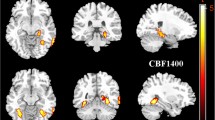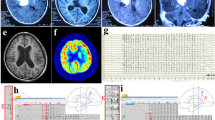Abstract
Cerebrovascular blood flow in absence seizures and flow patterns during the ictal period have not been thoroughly investigated. We aimed to evaluate cerebral blood flow changes in typical juvenile absence seizures during the ictal and postictal phases. Seizures were recorded in three patients (mean age: 21 ± 1 years) with multiple daily typical absence seizures. Simultaneous video electroencephalography and bilateral middle cerebral artery transcranial Doppler ultrasonography recordings were conducted during seizures. Basal, ictal, and postictal blood flow velocities were recorded bilaterally, and offline analyses were performed in relation with generalized spike and wave discharges. Total of 43 seizures were recorded. Ictal increase and postictal decrease of cerebral blood flow velocities were significant for both sides (P < 0.001). The interhemispheric asymmetry in the ictal velocity increase was significant (P < 0.05). The interhemispheric asymmetry in the postictal velocity decrease was not significant (P > 0.05). The blood flow velocity increase after seizure onset indicates a vascular coupling mechanism. A sudden and then a gradual decrease in blood flow velocity, which lasted even after the seizure ceased, might suggest a preventive mechanism to avoid excessive seizure duration or even an absence status epilepticus. Significant asymmetries in increase and a symmetrical decrease may support the cortical focus theory.

Similar content being viewed by others
References
Aaslid R, Markwalder TM, Nornes H (1982) Noninvasive transcranial Doppler ultrasound recording of flow velocity in basal cerebral arteries. J Neurosurg 57:769–774
Bode H (1992) Intracranial blood flow velocities during seizures and generalized epileptic discharges. Eur J Pediatr 151:706–709
Commission on Classification and Terminology of the International League Against Epilepsy (1989) Proposal for revised classification of epilepsies and epileptic syndromes. Epilepsia 30:389–399
Demirkaya S, Uluc K, Bek S, Vural O (2008) Normal blood flow velocities of basal cerebral arteries decrease with advancing age: a transcranial Doppler sonography study. Tohoku J Exp Med 214:145–149
De Simone R, Silvestrini M, Marciani MG, Curatolo P (1998) Changes in cerebral blood flow velocities during childhood absence seizures. Pediatr Neurol 18:132–135
De Simone R, Placidi F, Diomedi M, Marciani MG, Silvestrini M (2002) Inter-hemispheric asymmetry of cerebral flow velocities during generalized spike-wave discharges. J Neurol 249:1191–1194
Diehl B, Knecht S, Deppe M, Young C, Stodieck SR (1998) Cerebral hemodynamic response to generalized spike-wave discharges. Epilepsia 39:1284–1289
Klingelhöfer J, Bischoff C, Sander D, Wittich I, Conrad B (1991) Do brief bursts of spike and wave activity cause a cerebral hyper- or hypoperfusion in man? Neurosci Lett 127:77–81
Knake S, Haag A, Pilgramm G, Reis J, Klein KM, Hoeffken H, Bartenstein P, Oertel WH, Hamer HM, Rosenow F (2004) Ictal functional TCD for the lateralization of the seizure onset zone—a report of two cases. Epilepsy Res 62:89–93
Meeren H, van Luijtelaar G, Lopes da Silva F, Coenen A (2005) Evolving concepts on the pathophysiology of absence seizures: the cortical focus theory. Arch Neurol 62:371–376
Nehlig A, Vergnes M, Waydelich R, Hirsch E, Charbonne R, Marescaux C, Seylaz J (1996) Absence seizures induce a decrease in cerebral blood flow: human and animal data. J Cereb Blood Flow Metab 16:147–155
Nehlig A, Valenti MP, Thiriaux A, Hirsch E, Marescaux C, Namer IJ (2004) Ictal and interictal perfusion variations measured by SISCOM analysis in typical childhood absence seizures. Epileptic Disord 6:247–253
Niehaus L, Wieshmann UC, Meyer B (2000) Changes in cerebral hemodynamics during simple partial motor seizures. Eur Neurol 44:8–11
Panayiotopoulos CP (2007) A clinical guide to epileptic syndromes and their treatment. Springer, Berlin
Prevett MC, Duncan JS, Jones T, Fish DR, Brooks DJ (1995) Demonstration of thalamic activation during typical absence seizures using H2(15)O and PET. Neurology 45:1396–1402
Sanada S, Murakami N, Ohtahara S (1988) Changes in blood flow of the middle cerebral artery during absence seizures. Pediatr Neurol 4:158–161
Saito S, Yoshikawa D, Nishihara F, Morita T, Kitani Y, Amaya T, Fujita T (1995) The cerebral hemodynamic response to electrically induced seizures in man. Brain Res 673:93–100
Vollmer-Haase J, Folkerts HW, Haase CG, Deppe M, Ringelstein EB (1998) Cerebral hemodynamics during electrically induced seizures. Neuroreport 9:407–410
Wilder-Smith E, Nirkko AC (1991) Contribution of concurrent Doppler and EEG in differentiating occipital epileptic discharges from migraine. Neurology 41:2005–2007
Author information
Authors and Affiliations
Corresponding author
Rights and permissions
About this article
Cite this article
Bek, S., Kaşikçi, T., Genç, G. et al. Lateralization of cerebral blood flow in juvenile absence seizures. J Neurol 257, 1181–1187 (2010). https://doi.org/10.1007/s00415-010-5488-5
Received:
Revised:
Accepted:
Published:
Issue Date:
DOI: https://doi.org/10.1007/s00415-010-5488-5




